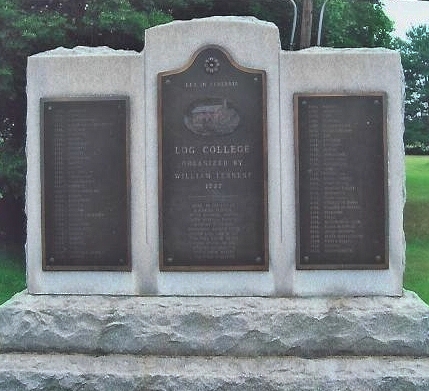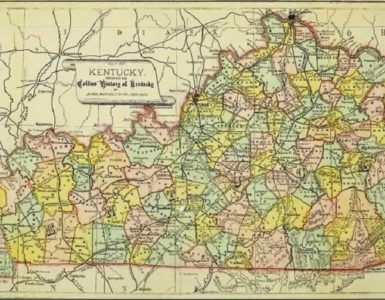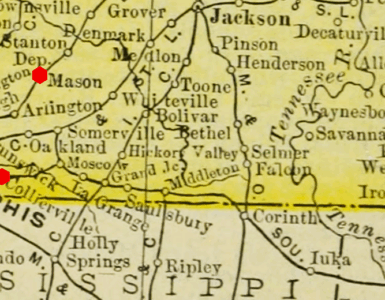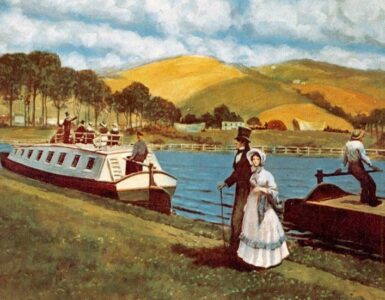If you dare risk your life and stand on the west shoulder of Highway 263 (York Road) in Warminster, Pennsylvania, just north of its intersection with Tennyson Drive, you can read the bronze historical plaques on the monument dedicated in 1927 bearing the name “Log College Memorial.” The memorial fixes the date of the founding of the Log College by New Side Presbyterian minister William Tennent at 1727. In early colonial days a candidate seeking a ministerial call would either be brought in from Ireland or Scotland, or if already living in the colonies, he had been educated in tutorial fashion by a minister. The Log College standardized the tutorial model into a more organized curriculum and trained many for the ministry. Tennent-trained clergy not only pastored local congregations but also mastered local schools for general education of young people. It was not unusual for fees from school teaching to be required by churches issuing a candidate a call in order to make up for their inability to supply a full salary. Sometimes nowadays ministers say they are pastor-teachers to indicate they are shepherds of the flock and essential to pastoring is teaching Scripture from the pulpit, catechetically, and in other ways, but at the time of the Tennents, if a minister had used pastor-teacher (I don’t think I have seen the term used in the era) the teacher part often included general and divinity education.
The inscriptions on the three plaques seen in the photograph of the front of the stone monument and the one plaque on the back of it (not pictured here) are transcribed below.
The colleges listed according to their dates of founding on the left and right bronze panels are as follows—
LEFT PANEL—1746, Princeton; 1771, Queens; 1776, Hampden-Sidney; 1787, Washington & Jefferson; 1794, Tusculum; 1812, Hamilton; 1819, Centre; 1819, Maryville; 1826, Lafayette; 1827, Hanover; 1827, Lindenwood; 1829, Illinois; 1832, Wabash; 1836, Davidson; 1842, Cumberland; 1842, Mary Baldwin; 1846, Carroll; 1849, Westminster, MO; 1849, Austin; 1850, Waynesburg; 1852, Dubuque; 1853, Western; 1854, Lincoln University; 1855, Elmira; 1857, Blackburn; 1857, Lake Forest; 1865, Lincoln; 1866, Albany; 1866, Wooster; 1867, King; 1867, Johnson C. Smith; and 1869, Trinity
RIGHT PANEL—1869, Wilson; 1872, Arkansas; 1875, Park; 1875, Parsons; 1875, Southwestern; 1880, South Carolina; 1881, Coe; 1882, Hastings; 1882, Emporia; 1883, Huron; 1883, Jamestown; 1884, Grove City; 1885, Macalester; 1886, Alma; 1887, Occidental; 1889, Daniel Baker; 1889, Agnes Scott; 1889, Missouri Valley; 1890, Whitworth; 1891, Buena Vista; 1891, College of Idaho; 1891, College of Ozarks; 1893, Belhaven; 1894, Tulsa; 1895, Westminster Utah; 1896, Flora McDonald; 1901, James Millikin; 1902, Texas Presbyterian; 1904, Davis & Elkins; 1906, Chicora (re-chartered Presbyterian); and 1923, Intermountain.
The text of the center panel reads—Lux in Tenebris / (image of the Log College) / Log College / Organized By / William Tennent / 1727 / Here, in the life of / a pioneer teacher, / sound learning, endued / with spiritual passion, / wrought to vitalize / knowledge, glorify truth, / enrich life, and in due / time call forth, to the / glory of God and the / welfare of American / youth these worthy / Christian colleges.
The plaque on the back of the stone memorial reads—Erected under the auspices of the / Presbyterian Historical Society cooperating / with the educational boards of the Northern and Southern Presbyterian churches, the / Presbyterian colleges of the country / and the presbyteries of Philadelphia, / Philadelphia North, and New Brunswick.
The sixty-three institutions listed on the two panels are in some cases familiar ones, such as Princeton, Davidson, Hampton-Sidney, and Lafayette, but others no longer exist, some have had their names changed, and still others have adopted new names when merging with other colleges. However, the colleges listed on the memorial are not a comprehensive enumeration of all the institutions influenced by the teaching of William Tennent in the Log College. One author, Donald G. Tewksbury, has commented in his statistically supported general analysis of early higher education in The Founding of American Colleges and Universities Before the Civil War, New York: Columbia University, 1932, that—
It is a well known fact that our colonial colleges were largely religious in origin and character, but it is not so well understood that, with the exception of a few state universities, practically all the colleges founded between the Revolution and the Civil War were organized, supported, and in most cases controlled by religious interests. Thus, it may be truly said that the ‘denominational college’ was the prevailing American college of the middle period of our history, as it was of the colonial period. (pages 55-56).
The author tallied 180 colleges using the 1860 United States Census and found that even though the Presbyterians had only 6, 379 congregations compared to over 12,000 Baptist churches and nearly 20,000 Methodist ones, the Presbyterians operated 49 colleges while the Methodists directed 34, and 25 were operated by the Baptists (p. 69). Tewksbury also observed that the driving force for all three denominations to establish colleges was the education of men for the ministry (p. 83-84).
Certainly, the United States has changed considerably since the days of the Tennents and their Log College. In the Colonial period and through the early Republic those who were educated at the college level, whether formally in an institution or tutorially, were generally ministers, doctors, educators, and lawyers. As influences from industrialization and technology developed the need for more engineering and sophisticated science curriculum, and Enlightenment thought sought to suppress theology in general—training of ministers moved out of colleges into separate institutions.
For additional reading on the Log College see Archibald Alexander’s, The Log College: Biographical Sketches of William Tennent and his Students, together with an Account of the Revivals under their Ministries, 1851, which has been reprinted by Banner of Truth.
Barry Waugh
The photographs were taken several years ago and the quality of the color has diminished with time.





